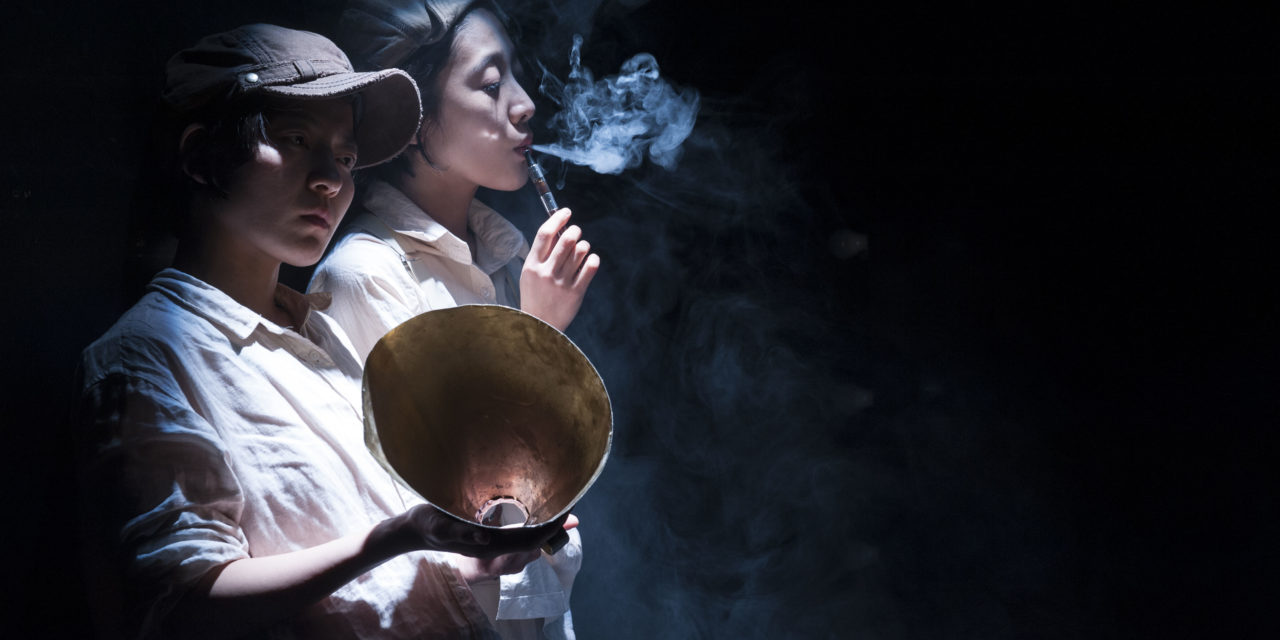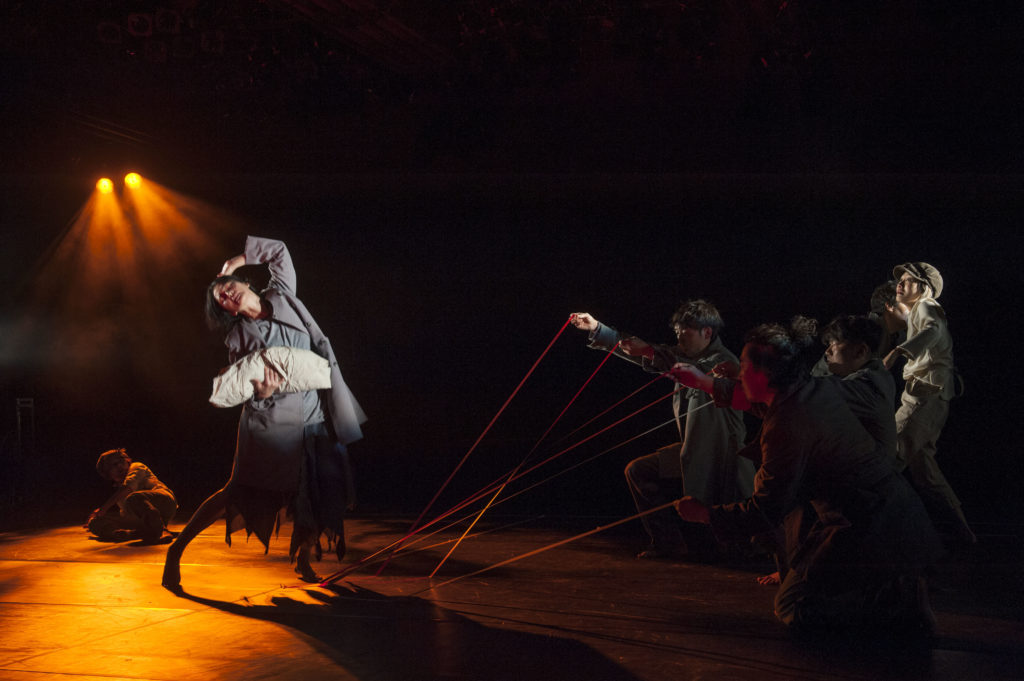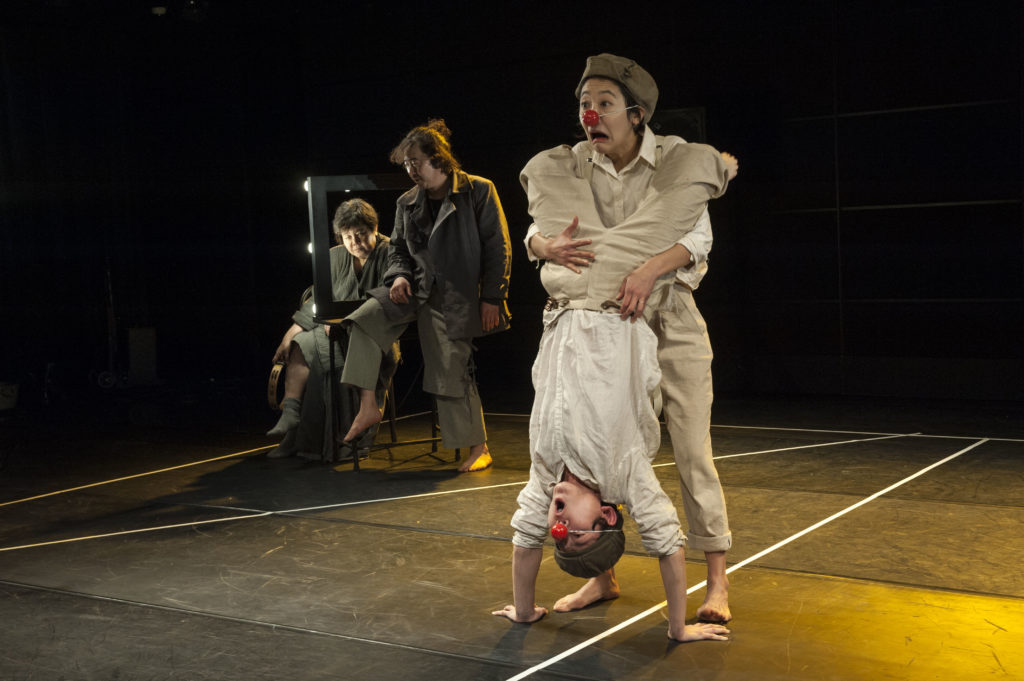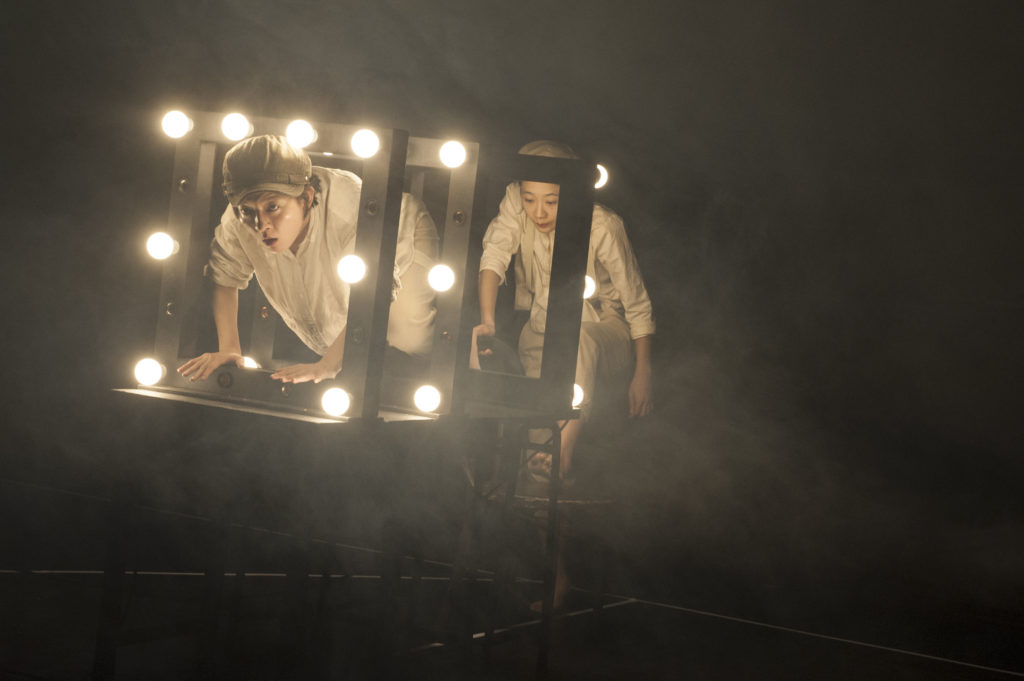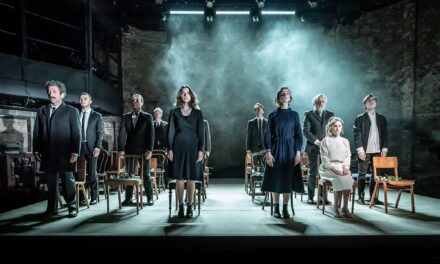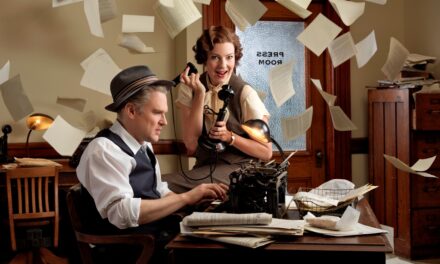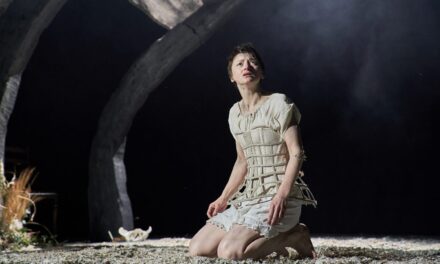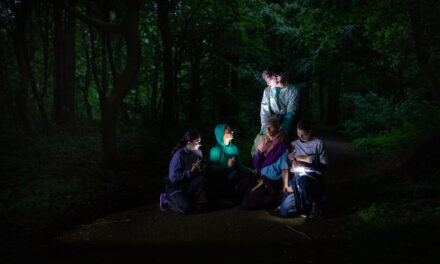In late 2016, a chaotic period both in and out of Korea, Doosan Art Center and Theatre Company Haddangse co-produced The Great Play (directed by Yoon Si Joong, Dec 3-29, 2016). This devised piece is based on Hungarian writer Agota Kristof’s novel The Notebook (Le Grand Cahier; 1986), the first of her Book of Lies trilogy. Kristof escaped Hungary after the failed Revolution of 1956 and lived in Neuchâtel, Switzerland, working in a watch factory during the day and writing poetry and fiction at night. The Notebook is a documentary-style novel based on her own childhood experiences, although she changed her five-year-old self and her six-year-old brother into male twins living through World War II. The Notebook immediately received critical acclaim in France and other European countries, winning the Prix littéraire européen d’ADELF. It has since been translated into over twenty languages.
PLAYING TO SURVIVE IN TIMES OF WAR
The source text of The Great Play records the struggle to survive during dangerous and cruel times of war. The narrators of The Notebook explain the rules: “the composition must be true. We must describe what is, what we see, what we hear, what we do.” They consult their father’s big dictionary but avoid using words that describe feelings. The young twins have fled the war in Big Town and now live in a rural area near the border with their witch-like grandmother. Abandoned by their mother, the twins live in fear, glancing around like scared animals. Yet they instinctively cling to life. The Nazi occupation army is close by, conducting secret operations. The rural natives live like beasts. Suffering from hunger, the twins learn how to steal. Beaten up, they learn how to fight. In need of money, they learn how to trade. After observing an officer execute a detective, they kill a cat. In roughly sixty short chapters, The Notebook recounts the dire lives of these twins as they grow up during the war.
In the process of adapting this written text into theatre, The Great Play condenses the events of The Notebook into twenty simple “games.” Here are some of these games that the twins play. The game of stealing. They steal food in response to hunger and their evil grandmother’s abuses. They catch fish after building a bridge out of wooden boards and bricks. They scavenge grenades from dead soldiers’ bodies in the woods and buy a goat with the money. Next, the game of building up their resistance against verbal and physical abuse. The twins practice cursing and slapping each other to get used to their neighbours’ unprovoked violence. They spend thirty minutes every day shrugging off insults from each other to become desensitized. Finally, the game of getting used to and imitating the war: They secretly observe and record the crimes and immoral acts of the people around them. For example, they pretend not to notice the harelipped woman next door have sex with a dog. Instead, they write it down in their notebook. The twins also turn a blind eye to the German officer’s sexual perversions and allow the Priest’s housekeeper to molest them. They kill a cat, completing their murder training. The twins tell their grandmother that they will kill anyone she wants dead. The game of the dregs of war. They watch prisoners stuff scraps into their mouths as they are dragged off by the retreating German army. They set fire to the Priest’s house, observe as the detective is shot dead, smoke the officer’s cigarettes, and witness Harelip’s death. Throughout these games, the twins switch back and forth between being observers (spectators) and agents (actors).
The Great Play ends with three deaths and the escape of one of the twins. Their mother runs into the yard, holding a baby that she had during the war. She dies instantly when a bullet hits her. The twins put the mother and baby’s skeletons in a corner of the yard and dry them out. When their grandmother suffers a stroke and wants to die, they pour poison in her milk. Their father, who managed to escape when the invaders fled and the liberation army swept in, tries to climb over the wire fence on the border. But he steps on a landmine. In the end, one of the twins take their grandmother’s jewels and cross the border, stepping over his father’s dead body. The twins say: “Yes, there is a way to get across the frontier: it’s to make someone else go first.”
A MONTAGE OF ROUGH SKETCHES AND THE DARK HUMOR OF PLAY
Structurally, The Great Play is a montage of rough sketches and various games. Although the narrative is set during one of the worst atrocities in human history, when Hungary was ravished by the political ambitions and warmongering of Germany and Russia, the things that the five-year-old twins see, hear, and do in the midst of the war are incompatible with a serious plot and character development. Instead, the director, Yoon Si Jung, used rough sketches to emphasize grotesque and subversive moments. He shaped The Great Play in twenty or so sketches, stringed together into a montage. He explored the idea of play for his style of representation. The essence of play is in freedom and the pleasure principle. Play encapsulates the child’s body and soul and is thus a perfect fit for the twins’ performance. As we see in madangnori, play allows us to resist oppressive social norms. (Translator’s note: Literally meaning “yard play,” madangnori is a traditional Korean performance form that takes place outdoors, encompassing mask theatre, dance, and drumming.) As such, play is the best way for the horrified twins to record the monstrous war according to “what we see, what we hear, what we do.” A rough sketch can serve as satire while play keeps reality at a critical distance.
Yoon’s directorial strategy of combining sketches and games to criticize the savagery of war was a great success. The Great Play is a black comedy that expresses the worst war in human history as a series of short sketches depicting a war-torn landscape, people on the border of life and death, savage acts of survival, and the desperate struggle to escape death. Through the twins’ innocent and terror-stricken eyes, the vulgar behavior of the adults shed their seriousness and cruelty, allowing the audience to take part in the dramatic fiction. However, once the audience began enjoying the scenes of brutal war and inhuman behavior, they would shudder with shock, suddenly realizing the nightmarish reality lying beneath the childish games. Then the audience would become somber. Perhaps it was because the critical function of play diverted from the twins’ games and reminded the audience that our everyday reality is in some ways a perpetual conflict as well.
Yoon has crafted The Great Play into an objective, unsentimental montage of sketches that is flexible and energetic enough to allow for different interpretations of the performance. However, there was one instance in which the twins’ internal unrest was visible. During the occupying army’s retreat, the twins’ mother arrives to take them with her. As she is crossing the yard, she is hit by a bullet and killed. This moment is repeated three times like a cinematic flashback sequence. The twins’ facial expressions and behavior vary slightly every time they see their mother die. To me, this scene represented the great inner tension and turmoil that the twins felt as they confronted this unchanging reality: their mother’s death. This was the only moment in The Great Play when emotion invaded “reality.” Although they sever themselves from all emotion, the death of their mother created shockwaves in the twins’ unconscious, as if the foundations of their lives fell apart. Of course, Yoon added no commentary to this scene. Without cries or sound effects, the scene felt like a strange daydream. However, that neutrality was truly devastating.
AN ACTOR’S THEATRE ON A BARE STAGE
The Great Play is performed on a bare stage. When the action demands objects, the performers bring them onstage as part of the scene, use them, and remove them as needed. These objects create the various locations in the dramatic fiction, suggesting or giving form to certain situations. For example, when the performers stretch a long piece of white boxing tape across the stage floor as if drawing a straight line, a boundary is drawn and theatrical space is produced. When the grandmother enters with a wheelbarrow, the garden—the “workplace” where the twins slave away—is established. In this way, the stage does not transition through actual locations. Instead, imaginary spaces come together and scatter based on the presence of the actors and their relationships. Objects also dictate the creation and erasure of imaginary spaces. Yoon, who both directed and designed the production, uses the emptiness of the stage to his advantage so that audiences can fill it with their imagination.
The Great Play emphasizes the actors’ physical movement and their metaphoric/metonymic interaction with objects. The performers’ gestures and manipulation of props create time, space, and situation. They “write” their own reality. Moon Sook Kyung and Lee Soo Hyun portray the young male twins. These two female performers seem utterly oblivious of conventional morality or the rules of the adult world. They go along with the devastating events around them. Imitating the violence, theft, and lies of the adults, Moon and Lee depict the subtle development from young boys to conceited preteens through their physical gestures, facial expressions, and manner of walking. When the performance begins, they are children: innocent and frightened. As time passes, they become acclimated to the deceitful ways and brutality of the adults, turning into shameless, crafty youths. When they witness bestiality, they are shocked, but they also make fun of it and whisper to one another. Later, they become adept liars. The two performers make this transformation seem natural. During the performance, Moon and Lee were not actresses; they were quick-minded twin boys. Nam Mi Jung shined in her portrayal of their cruel grandmother (nicknamed the Witch) with the demeanour of a wide-mouthed angler who spews profanity. She was an old woman who cared only for herself and yet had the charisma to sway everyone around her. Even when the grandmother passes down her hidden treasure to her grandsons on her deathbed, half of her words are curses. All of the performers in The Great Play threw themselves at their roles. The performers who played many different characters were especially fluid and improvisational in their transition from role to role.
Seo Sang Kwon, the onstage musician, didn’t simply provide musical accompaniment for the performance. He skillfully played the double role of musical director and narrator, leading the emotional tone of the performance. He moved around the stage playing the accordion before the audience entered, commenting on the cast’s warmup routines. During the performance, he stepped in and out of the stage, at times one of the characters and other times a member of the crew. His accordion added a hint of lyricism to the dire atmosphere of war. Despite the heavy and depressing subject matter, Yoon’s light and swift directorial style brought life to the stage. The neutral and open stage with minimal set dressing allowed for audiences to be immersed in the various sketches and games. At the same time, when the stage was briefly empty in between sketches, the audience had a chance to reflect on this fable of war and its connections to issues in the real world.
WHAT WILL THE TWINS RECORD ABOUT OUR OWN TIME?
The Great Play is a war story that combines horrific reality with dark humor. It is erected over the paradox that savage war is also an elaborate game. In this paradoxical war, the greatness and savagery of Western rationalism reveal itself as two sides of the same coin. War and play are also conjoined. The common phrase “savagery in the guise of civilization” is key to this production. In that sense, to change the title of the original novel, The Notebook, into The Great Play was a masterful stroke.
Today, war has become a part of everyday life. The occupying armies of World War II may have all withdrawn, but the world is currently ravaged by an infinite number of smaller conflicts. Aside from the classical war that soldiers fight, there are now nuclear wars, religious wars, trade wars, technology wars, information wars, political wars, and diplomatic wars. If traditional warfare was straightforward and ruthless, the wars of the new millennium are ambiguous and deceitful. Crass capitalism has created all kinds of fetishes and social problems, unnamed mass panic runs rampant, and technology has been corrupted into the destroyer of civilization. People around the world, many of which are ensnared in local conflicts, are unable to distinguish between truth and falsity. They are nervous, on the run, battered. For all of us living through these times, “survival” has become a pressing theme. What can we learn from these twins and their survival tactics? How can we respond to this chaotic age and make it safely to the future?
The Great Play does not explore World War II as a historical event but rather exposes the “bare reality of war.” It asks audiences what will happen to humanity when the rivers of conflict flood over the present and the future. In the glorious/hideous twenty-first century when countless wars dot the globe like poison mushrooms, The Great Play offers a bitter message. What is written in the secret notebook, which only records “what is, what we see, what we hear, what we do” today and tomorrow?
Shin Hyunsook is Professor Emerita at Duksung Women’s University. Her interests include intercultural theatre and myth and theatre.
Translated by Kee-Yoon Nahm
This article was originally published in Korean Theatre Journal, the official journal of the International Association of Theatre Critics – Korea. Reposted with permission.
This post was written by the author in their personal capacity.The opinions expressed in this article are the author’s own and do not reflect the view of The Theatre Times, their staff or collaborators.
This post was written by Shin Hyunsook.
The views expressed here belong to the author and do not necessarily reflect our views and opinions.

